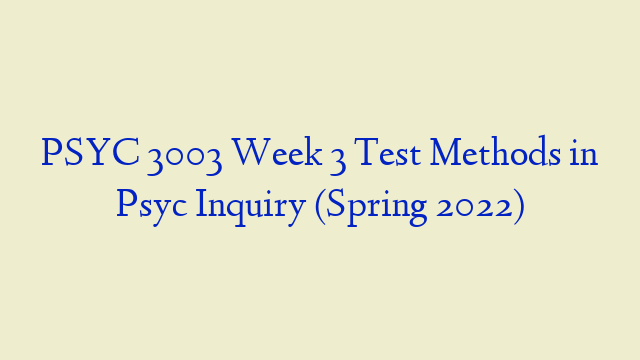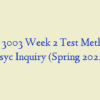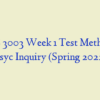Description
PSYC-3003-1-Methods in Psyc Inquiry-2022-Spring-QTR-Term-wks-1-thru-6
Test – Week 3
- Steve wants to measure attraction by measuring individuals’ heart rates. In this case, heart rate is the variable and attraction is the variable.
- Measuring how many times a person bites their nails in a two-hour period is an example of
- Consider the following item that might appear on a Likert scale: “I normally do not get along well with other people.” Such an item has high validity but may not have validity because respondents may not answer it honestly.
- A researcher who measures learning using both a self-report measure and a behavioral measure is using which principle?
- Which of the following statistics would be used to assess the reliability of a set of raters who used a nominal variable to code behavior?
- A researcher is developing a Likert scale to measure the self-esteem of a group of college students. He considers self-esteem to be a state, in the sense that it will change from day to day based on a person’s experiences. Which of the following forms of reliability should he use to assess self-esteem?
- Why are Likert scales written so that on half of the responses, agreeing with the item means the person has the variable being measured, whereas on the other half, agreeing with the item means that the person does not have the variable being measured?
- The students in Dr. Miller’s class are complaining that, although the exam was supposed to cover chapters 1 through 5, the test only covered chapters 1 and 2. Why are the students upset?
- In order to better understand how individuals react to a questionnaire before using the questionnaire in a research project, the researcher may wish to
- While taking a projective test, Neeka states that she has higher self-esteem and is more successful than most other college students. This response might represent which of the following?
- Interrater reliability measures consistency.
- A school superintendent has received a report from the state that lists the ranking of schools in terms of the student’s performance on the state’s achievement test. Which scale of measurement is represented in this report?
- Reliability is used to assess, whereas validity is used to assess.
- The nomological net refers to
- A psychologist asks her patient to describe her daily routine. This measured variable is an example of
- According to your textbook, scores on a Likert scale represent one of the following?
- Which of the following is the best operational definition of intelligence?
- William decides to study the differences in students’ interests in their psychology class. He figures that people who are more interested in the class will come to class more often, so he keeps track of class attendance. In William’s research project, interest in the class is which of the following?
- Donna is in a two-part experiment. She completed a self-esteem measure one week ago and is now taking the same measure again. Which of the following problems may arise from this process?
- A scale that asks participants to check off as many items as applied from a list is probably which type of scale?
- Which of the following best describes the Rorschach inkblot test?
- A researcher who used a self-report measure of job interest to predict performance on a managerial task would be interested in of her self-report measure.
- An operational definition
- Individual difference variables that are expected to vary over a period of time are called, while variables that are not expected to vary over time are called.
- Which of the following would be the best example of a nonreactive behavioral measure?
- Which of the following statements is true?
- Discriminant validity refers to
- The reliability of a test refers to the extent that the test is free from
- For both physical and psychological measurement, the lowest scale of measurement involves categorizing the stimulus into one of a number of discrete categories (e.g., brown-eyed or blue-eyed). This level of measurement is called a(n)
- Which of the following is true about the difference between random and systematic error?




